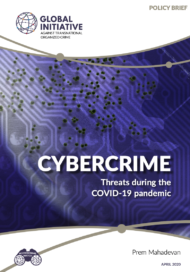Posted on 06 May 2020
The risk of cyber child exploitation has grown dramatically as populations worldwide are forced to spend more time at home and online.
The COVID-19 pandemic has had a dramatic effect on internet usage. Home is the new hub. Since mid-January 2020, online traffic has increased by over 25% – the fastest usage increase since the internet was developed. This has brought hundreds of millions of schoolchildren into online classrooms overnight. It has also led to increased risks of online child exploitation.
Even before the pandemic, every law-enforcement agency worldwide was massively overworked. Available resources did not match the needs. Each case had to be triaged, which inevitably meant many were not addressed. Police resources were reserved largely for the most egregious cases, leaving a constant stream of offenders untouched. In other words, the pandemic has increased the pressures on systems that were already severely strained.
Current evidence from police reports produced by INTERPOL member countries, as well as international child-protection organizations and activist groups that monitor the ‘dark web’, indicates sexual predators who target children are organizing among themselves to exploit the opportunities presented by the COVID-19 lockdown.
In Canada, the Child Protection Centre (CPC) monitors known paedophile groups. In early April, the CPC alerted online safety groups to this chilling message, published on and extracted from a paedophile bulletin board: ‘With potentially millions of boys around the world being or soon to be forced to stay home from school, potentially unsupervised if parents are working (teens in particular) now is the time for cappers to do their part to assist the quarantine efforts. There is a dire need for enriching, structured activities for all these boys to engage in.’
Recent reports have indicated a rise in child-abuse cases resulting from COVID-19 sheltering-in-place orders, and home is not always a wholesome place for every child. By contrast, school is often a safe haven from family stress; a place where a child can get a nutritious meal and spend time with teachers, coaches and other adults who look out for their best interests and welfare. The absence of the regular physical presence of these protectors is in itself a source of increased risk.
At home, if parents are spending more time together it may lead to greater stress within the family. February and March data from China and Europe indicates that domestic violence increased following lockdown orders. In March, French authorities reported a 30% increase in domestic-violence reports the week after the stay-at-home order went into effect.
How does this violence influence online behaviour? When children witness domestic violence, or when they are subjected to it, online environments can seem ever more attractive, a virtual refuge. This puts them at even greater risk from manipulative predators who seek them out under the guise of providing friendship at a vulnerable moment.
Unfortunately, despite their best efforts, even the most nurturing and compassionate adults are also under financial and personal stress. They may be all too happy to allow children to keep themselves amused quietly in their room, on a games console or similar, while they work, prepare meals, clean and disinfect, or look after other children.
Yet, just as wearing face masks and washing hands are the first line of defence against the coronavirus, awareness among primary caregivers of the risks of online child exploitation is also the first and necessary step in preventing it. Because many schools have moved online indefinitely, school administrators should, at the very least, email parents a reminder about what can go wrong; how to minimize the risks of anything actually going wrong; and what to do if, despite their best endeavours, things do go wrong.
Internet companies also need to do their part. Most worldwide electronic-communications providers have issued statements saying they take the protection of children very seriously and are implementing various measures to further the cause, but monitoring groups have yet to see evidence of an appreciable impact. Despite these moves, cases of violence against children still seem to be going up. Some electronic-communications providers have offered encryption upgrades on services that are currently unencrypted, but this will make it even harder for law enforcement to detect exploitation, apprehend offenders and protect children.
Some internet companies do heroic work to stamp out online offences against children; however, others do not. No one currently knows who falls into which camp. This uncertainty is rooted in a lack of transparency, which, in turn, allows for potentially considerable inconsistency. It is a major problem.
It is therefore urgent that we establish a transparency regime for electronic-communications providers. Companies should be asked to state publicly if they are acting to protect children who use their services, and specify the general nature of the measures they are taking. This would enable the public to compare each business with its competitors.
Such a regime would have to be verified by a trustworthy, independent source that can say with confidence: ‘Company X claims it is deploying tools to detect and delete child sex abuse material on its sites and services, reporting it in a timely way to the proper authorities. We have tested their system and can confirm that this appears to be true and, at the time of testing, the systems were working well.’
Perhaps the same independent source could also vouch: ‘Company Y claims to have systems in place to detect and delete child sex abuse material on its sites and services, reporting it in a timely way to the proper authorities. We have been unable to find any evidence to support this claim.’
If senior executives provide this kind of information, it will give policymakers an insight into what is actually happening in their country and, crucially, it will provide parents with a reliable helping hand when deciding how to keep the internet as safe for children as possible. Like robust testing for COVID-19, transparency provides social protection. It will ensure businesses are walking the walk online, and not just putting seemingly reassuring words in glossy press releases.



